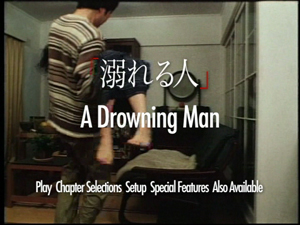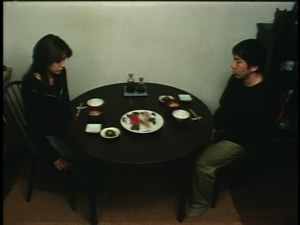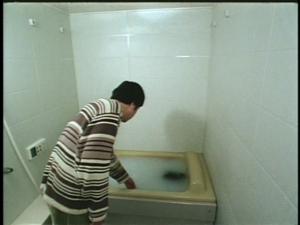| Reviews & Columns |
|
Reviews DVD TV on DVD Blu-ray 4K UHD International DVDs In Theaters Reviews by Studio Video Games Features Collector Series DVDs Easter Egg Database Interviews DVD Talk Radio Feature Articles Columns Anime Talk DVD Savant Horror DVDs The M.O.D. Squad Art House HD Talk Silent DVD
|
DVD Talk Forum |
|
|
| Resources |
|
DVD Price Search Customer Service #'s RCE Info Links |
|
Columns
|
|
|
Drowning Man, A
THE MOVIE:

Released in 2000, A Drowning Man is Naoki Ichio's first and so far only motion picture. The Japanese filmmaker wrote, edited, produced, and directed the movie, displaying a steady hand and a distinctive eye. His press clippings compare him to Spanish surrealist Luis Bunuel, but I think his most obvious compatriot is not a filmmaker, but an author. A Drowning Man reminds me a lot of the short stories of Haruki Murakami.
At the start of the film, Kumiko (Reiko Kataoka) drifts off to sleep while she takes a bath. She dreams of being in a beautiful, open field with purple flowers. She also realizes that she's not merely sleeping, but she's dead, having drowned. Apparently, death is merely another dreamscape. Naoki Ichio uses this as his springboard to suggest that life is merely a dream, as well. Everything we experience is just another state of illusion. We stand between two mirrors, and they reflect our image back to us, multiplying into infinity.
Kumiko's husband, Tokio (Shinya Tukamoto), finds her in the bath, but instead of calling for an ambulance, he drains the tub and removes her body, laying her out on the couch as if she were taking a nap. He then goes and sleeps under the kitchen table, waking up only after his wife has regained consciousness and rouses him. Did she ever really die, or did he just dream it himself?
It's quite a set-up for a film. In other hands, it might be overly weird, with a forced atmosphere and overstating the point. Ichio is a gentler director, he wouldn't force anything. His odd concept is a metaphor for the malaise felt by two people in a dying relationship, and he adopts that mood to establish the tone of his movie. With Kumiko seemingly acting strange after the incident--her skin is always freezing cold, she eats food she's never liked before, the apartment has a rotting smell that no amount of cleaning will dissipate--Tokio begins to doubt himself and what he knows. Kumiko never really opens up about what she thinks happened, suggesting a lack of trust between them. They do address the divide, but they mostly tip-toe around it. They are sleeping through their marriage and they need to snap out of it.
A Drowning Man is a small movie. It's barely over 80 minutes long, and it never really leaves the couple's apartment. Long passages go by without anyone speaking, and most of the shots are cloaked in darkness. Though there is a faint whiff of pessimism in Ichio's resolution, the very final scene reveals the optimism he's been guarding all along. By embracing the illusion, we are free to live it. It's a grand revelation, but the neophyte director unveils it almost on the sly, so far from any fanfare that you might not even catch it at first. You have to think that if he's smart enough to take it that far, that his own perspective on what must be a very personal film is that it is also a layer to the dream, a fabrication of one man's mind. It's been seven years since he shared it with the rest of the world, I can only wonder what he's been dreaming of since.

THE DVD
Video:
I can't say I was surprised that the picture quality for the A Drowning Man DVD wasn't very good. Right when I received the disc, before I had taken off the plastic, I noticed the poor reproduction quality of the box art. The fuzzy letters and over-saturated coloring make it look like it was printed on someone's laser printer rather than a professional printing job. You'll notice the same fuzzy lettering as soon as the movie begins and you see the white credits on a black screen. The transfer on A Drowning Man is pretty terrible.
The movie is presented in a full frame format. I don't know if that is its original aspect ratio, I can't find any information on that. The picture is extremely soft regardless of what size it is in, with dull colors, the occasional speck of dirt, and a persistent background haze, like maybe this was mastered from an old VHS or something.
Sound:
Only one basic audio mix is offered of the original Japanese soundtrack. Though A Drowning Man is a very quiet film, this flat mix still has some very noticeable flaws, since there is a pretty obvious imbalance between the music and the spoken dialogue. All in all, it has a kind of distant quality, like the audio lacks the same sharpness missing from the video.
Yellow English subtitles are optional, and they are decently written with only a couple of typos.
Extras:
Most of the bonus features are text based and can be scrolled through using the arrows on your remote control. These include liner notes by critic Roseanne Lawrence (I assume she's a critic of some kind, no one bothers to give her an explanatory byline despite her presumably being someone worth paying for her opinion), production notes, and biographies of the participants. There is also an image gallery of stills.
The video portion of the bonus section has both the U.S. and Japanese trailers for A Drowning Man and a selection of trailers for other DVDs from Pathfinder Pictures. There is also a 16 minute, 45 second "Making of..." documentary. This is entirely put together with on-set footage, leading us through the production at a brisk pace. It's absent of any of the usual interviews with actors or director, but is more quiet and unassuming, like the movie we're seeing be filmed.
FINAL THOUGHTS:
Packaging is important to DVD collectors, and this is a case where the package doesn't live up to the movie it contains. From top to bottom, from the cover art through to the DVD authoring, this release of A Drowning Man was done on the cheap. On those merits, I'd likely tell you to skip this DVD completely; however, Naoki Ichio's movie is such a special little puzzler, it balances out the disc's average. The intriguing dissolution of this Japanese marriage, with the rift between the husband and wife manifesting as illusory metaphors that neither can adequately explain, makes for a special film that deserves to be seen and pondered. So, despite the presentation, Rent It, because it's worth seeing regardless of how its shown.

Jamie S. Rich is a novelist and comic book writer. He is best known for his collaborations with Joelle Jones, including the hardboiled crime comic book You Have Killed Me, the challenging romance 12 Reasons Why I Love Her, and the 2007 prose novel Have You Seen the Horizon Lately?, for which Jones did the cover. All three were published by Oni Press. His most recent projects include the futuristic romance A Boy and a Girl with Natalie Nourigat; Archer Coe and the Thousand Natural Shocks, a loopy crime tale drawn by Dan Christensen; and the horror miniseries Madame Frankenstein, a collaboration with Megan Levens. Follow Rich's blog at Confessions123.com.
|
| Popular Reviews |
| Sponsored Links |
|
|
| Sponsored Links |
|
|
| Release List | Reviews | Shop | Newsletter | Forum | DVD Giveaways | Blu-Ray | Advertise |
|
Copyright 2024 DVDTalk.com All Rights Reserved. Legal Info, Privacy Policy, Terms of Use,
Manage Preferences,
Your Privacy Choices | |||||||














